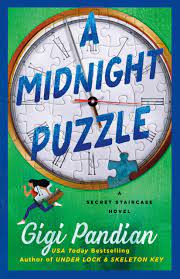What’s a puzzle plot mystery?
In a “fair play” puzzle plot mystery, the author provides the reader with all the clues, allowing the reader to match wits with the detective. All the pieces of the puzzle are hidden in plain sight.
The genre was at its height in the Golden Age of detective fiction in the 1920s and ‘30s, and continued in popularity for decades. Ellery Queen novels (1929 – 1971) were famous for Ellery directly addressing the reader at the point in the story in which both the reader and the detective had all the clues needed to solve the mystery. Ellery presented a “challenge to the reader.” Who would solve it first?
On the most devious end of the puzzle plot spectrum, you’ll find locked-room mysteries and impossible crimes, where a crime isn’t just puzzling but looks as if it’s truly impossible. (A deeper dive into locked-room mysteries can be found here and here.)
A resurgence in the genre
Thanks to modern developments such as publishers reprinting out-of-print books from the Golden Age of detective fiction, mysteries from around the world being translated into English for the first time, and wonderful podcasts including Shedunnit and All About Agatha, there’s been a modern resurgence in interest in Golden Age style puzzle plot mysteries.
Here, I’m highlighting a handful of present-day authors putting their own spin on the classic genre. If you love classic puzzle plot mysteries, I encourage you to seek out these authors and more.
Cluefinders, sealed solutions, and directly challenging the reader
Several modern authors are bringing back delightfully playful elements from classic puzzle plot mysteries, including cluefinders, sealed solutions, and directly challenging the reader.
Martin Edwards is one of the people helping bring Golden Age mysteries back into print through the British Library’s Crime Classic series and his nonfiction, but he’s also leading the way through his Rachel Savernake Golden Age Mysteries. Mortmain Hall and The Puzzle of Blackstone Lodge both resurrect a fun element of mystery novels not seen in decades: a cluefinder. Cluefinders are lists at the end of novels that spell out all the clues, including the pages where the reader can find them, so readers can review what they spotted or missed.
Tom Mead’s Joseph Spector mysteries feature the most baffling type of puzzle: impossible crimes. His debut novel Death and the Conjuror gives all the clues to the reader—and the Japanese edition even includes a sealed solution section. Nearly a century ago in 1929, the Harper Brothers launched a “Harper’s Sealed Mystery” series with the end pages of their mystery novels sealed. Once a reader broke open the solution pages, they could no longer return the book.
Both Edwards and Mead write historical settings that evoke the Golden Age mysteries they pay homage to, but other authors are writing similar puzzles in present-day settings and openly playing with conventions.
Comedian Benjamin Stevenson writes modern whodunnits set in Australia, with fair play clues explicitly spelled out as a challenge to the reader. In both Everyone in My Family Has Killed Someone and its follow-up Everyone on This Train is a Suspect, the narrator directly addresses the reader throughout the book, telling them exactly where to find the clues they need. The clues are cleverly hidden, of course, but it’s deliciously fun to attempt to work them out.
Characters for a modern world
One complaint that some modern readers have of Golden Age novels is a lack of character depth. While I disagree with this critique, especially in books by authors whose books have stood the test of time, it’s true that characters’ personal lives were less central than they are in most current mysteries. Well-rounded diverse characters were also difficult to find in Golden Age novels, even though it’s historically accurate to find a wide range of cultures and intermarriages in that time period.
Christopher Huang has incorporated a multicultural main character into a Golden Age style historical mystery. Huang’s A Gentleman’s Murder features a puzzle plot with many familiar tropes, such as a murder at a gentleman’s club in London, but his sleuth is half English and half Chinese. Singaporean-Canadian Huang adds depth to the mystery by weaving in background details of British colonialism, but the focus is the traditional puzzle plot.
J.L. Blackhurst’s Three Card Murder, the first in her Impossible Crimes series, deftly places a twisty fair play mystery in a modern police procedural. The mystery perfectly blends fully modern sensibilities and family drama with baffling clues that the biggest fans of classic mysteries will delight in when the clever solution is revealed.
My new novel A Midnight Puzzle is my own modern spin on the classic puzzle plot mysteries I love reading. When I set out to write a series focused on locked-room mysteries, I wanted to give readers the same joy I feel when a cleverly constructed puzzle comes together, but also add the character depth that I enjoy in modern novels. Sleuth Tempest Raj isn’t only using her skills as a stage illusionist to see through misdirection and solve a murder involving a mysteriously regenerating booby trap. She’s also getting help from her multicultural family and the quirky crew of Secret Staircase Construction as she unearths family secrets that give her the last pieces of the puzzle.
Present-day puzzle plot mysteries aren’t identical to those from a century ago, but if you follow the clues above to find your next great read, I guarantee plenty of fair play fun.
***


















